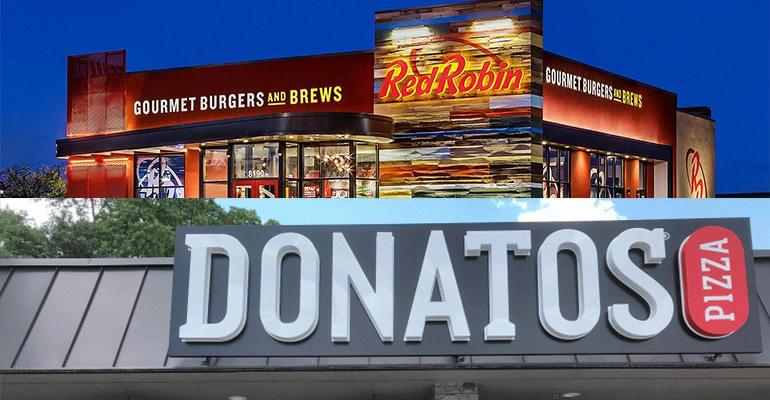Red Robin Gourmet Burgers Inc. expects to complete its rollout of Donatos pizza additions to company-owned restaurants by 2023, executives said Wednesday.
The Greenwood Village, Colo.-based casual-dining concept launched the Donatos partnership in 2020, before the COVID-19 pandemic was declared, and earlier this year said it would expand the pizza offering into 120 more of its restaurants this year.
“It represents a substantial catalyst for growth,” said Paul Murphy, Red Robin’s president and CEO, in a fourth-quarter earnings call Wednesday.
“We believe Donatos will generate annual company pizza sales of more than $60 million and profitability of more than $25 million by 2023, when we have completed our roll out to approximately 400 company-owned locations,” Murphy said.
Donatos will be in 200 of Red Robin’s 443 company-owned stores by the end of this year, he said
“Donatos provides significant growth opportunities, beyond the addition of new restaurants, including an opportunity for growth in catering as we expand this category post-pandemic,” Murphy said.
Lynn Schweinfurth, Red Robin’s chief financial officer, said Red Robin units that offered Donatos in the fourth quarter outperformed non-Donatos restaurants with COVID-19 indoor dining restrictions by more than 500 basis points.
The company, in its outlook, said it expects Donatos to drive incremental flow-through of $45,000 in the second year, “yielding a three- to four-year payback period.” Start-up costs in the first year include pre-opening expenses of $12,000, first-year marketing investments of $30,000 and capital of $145,000 per restaurant.
Murphy said Red Robin is working to retain off-premise food and beverage sales that grew during the coronavirus pandemic.
In the fourth quarter 2019, before the pandemic, Red Robin’s off-premise sales comprised about 14% of total food and beverage sales, but Murphy said those expanded as COVID-19 restrictions closed dining rooms and are being retained as capacity limits ease.
“Restaurants that have less than 50% capacity, we're seeing the off-premise sales about 55% of the total,” he said. “In restaurants that have 50% to 74% capacity, we're seeing the off-premise sales mix of approximately 38%. And then the restaurants that are 75% or greater, we're seeing them level at 31% in terms of off-premise sales.”
As of Feb. 28, Red Robin had reopened 372 indoor dining rooms with limited capacity, representing about 87% of its open company-owned restaurants.
For the fourth quarter ended Dec. 27, Red Robin’s widened its loss to $39.3 million, or $2.53 a share, from $7.7 million, or 60 cents a share, in the same period last year. Revenues fell 33.6% to $201 million from $302.9 million in the prior-year quarter.
Same-store sales declined 29% in the quarter, which was primarily driven by restrictions on dining room capacities in key states, including California, Colorado, Oregon and Washington, Schweinfurth said.
As of Dec. 27, Red Robin had 546 restaurants, with 443 of those company-owned and -operated. The brand was founded in 1969.
Contact Ron Ruggless at [email protected]
Follow him on Twitter: @RonRuggless





